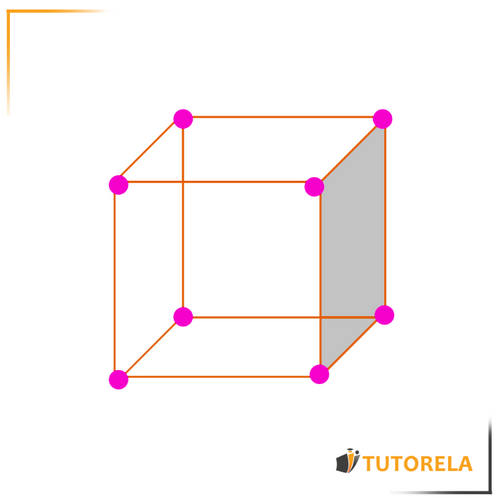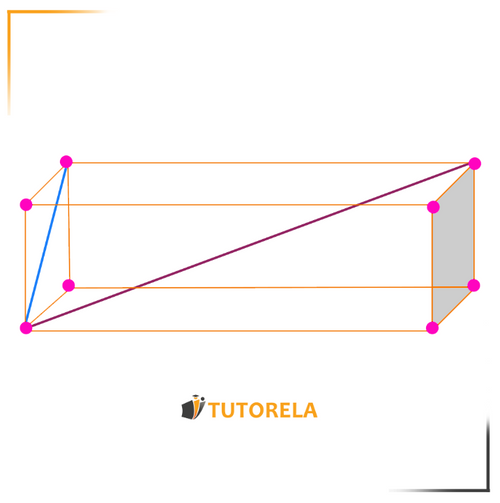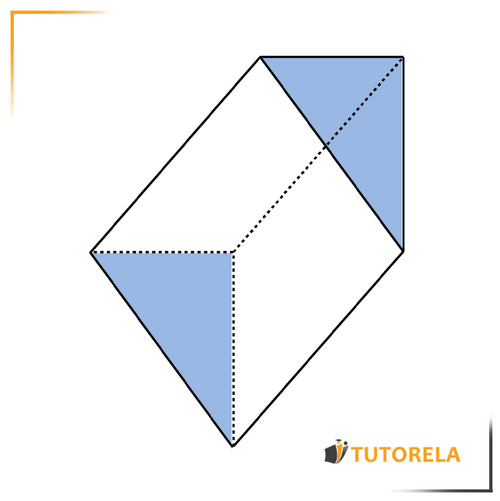So far we have worked with common two-dimensional figures such as the square or the triangle.
Three-dimensional figures are those that extend into the third dimension, meaning that in addition to length and width, they also have height (that is, the figure has depth).
Three-Dimensional Figures
Three-dimensional figures
What are three-dimensional figures?
What differences do three-dimensional figures have?
Three-dimensional figures have several definitions that we will see next:
Below is a three-dimensional figure that we will use to learn each definition - The cube:

Face: it is the flat side of a three-dimensional figure
In the cube we have here, there are 6 faces (one of them is painted gray)
Edge: these are the lines that connect one face to another in a three-dimensional figure
In the cube we have here, there are 12 edges (painted green)
Vertex: it is the point that connects the edges
In the cube we have here, there are 8 vertices (painted orange)
Volume: it is the amount of space contained within a three-dimensional figure.
The units of measurement are .
Test yourself on cuboids!
Below is a cuboid with a length of
8 cm.
Its width is 2 cm and its height is
4 cm.
Calculate the volume of the cube.
Cuboid
The cuboid is a three-dimensional figure composed of 6 rectangles.

Each cuboid has:
6 faces: the rectangles that make up the cuboid - three pairs of rectangles that can be different from each other.
12 edges: the edges of the cuboid (divided into length, width, and height) - marked in green
8 vertices: the points where the edges meet - marked in orange
You can learn more about the parts of the cuboid by reading this article
Face diagonals:
The diagonals that go from one vertex to another on the same face as long as the vertices belong to the same face - marked in blue
Diagonal of the cuboid:
The diagonals that go from one vertex to another on different faces, as long as the 2 vertices belong to the same face - marked in red
Volume of the cuboid
The volume of the rectangular prism is ( \times \~the~width~\times \~the~length\~the~height\)
For more information about the volume of the rectangular prism click here
A cuboid has a length of is 9 cm.
It is 4 cm wide and 5 cm high.
Calculate the volume of the cube.
Look at the the cuboid below.
What is its surface area?
Look at the cuboid below.
What is its surface area?
Surface area of a cuboid
The formula to find the surface area is(width\times length + height\times width+ height\times length)\times \2
You can read again about the surface area of a rectangular prism by clicking here
Lateral area of a cuboid
It is the sum of the area of the four lateral rectangles (without the bases).
The lateral area of a cuboid can be calculated with the following formula:
a- Length
b- Width
h- Height
2\times \ah+2\times \bh= lateral~area~of~a~cuboid
You can read again about the lateral area of a cuboid by clicking here
For more information about the cuboid click here
An unfolded cuboid is shown below.
What is the surface area of the cuboid?
A cuboid has the dimensions shown in the diagram below.
Which rectangles form the cuboid?
Identify the correct 2D pattern of the given cuboid:
Cylinder
The cylinder is a three-dimensional figure composed of two identical parallel circles called bases, between which the lateral area expands.
Other properties:
The distance between the two bases is constant and is called the height of the cylinder - we will mark it with an
The radius of both bases is equal, we will mark it with an
Volume of the cylinder
The volume contained within the cylinder is usually denoted by .
Formula to calculate the volume of the cylinder:
When:
= PI ()
= Radius of the base
= Height of the cylinder
For more information about the volume of the cylinder click here
An orthohedron has the dimensions: 4, 7, 10.
How many rectangles is it formed of and what are their dimensions?
What are the dimensions of a cuboid composed of two 4X3 rectangles
and of four 4X4 squares?
What display can describe an cuboid whose dimensions are 2X3X4?
Total surface area of a cylinder
The total area of the lateral surface and the two bases - we will denote it with
We will use the formula:
When:
= PI ()
= Radius of the base
= Height of the cylinder
For more information click here
Lateral area of a cylinder
Only the lateral area without the bases. We will denote it with
We will use the formula:
2πR\times \H
When:
= PI ()
= Radius of the base
= Height of the cylinder
For more information about the cylinder click here
Calculate the volume of the cuboid
If its length is equal to 7 cm:
Its width is equal to 3 cm:
Its height is equal to 5 cm:
Which dimensions may represent a cuboid?
Shown below is a cuboid with a length of 8 cm.
Its width is 2 cm and its height is 4 cm.
Calculate the volume of the cube.
Prism
The right triangular prism is a three-dimensional figure that is composed of 2 triangles and 3 rectangles:

Base of the prism: the 2 triangles that compose it will always be identical (marked in orange).
The triangles can be isosceles, scalene, or equilateral.
To delve deeper into the topic of the bases of the prism click here
Faces of the prism: the 3 rectangles that make up the lateral faces - they will not necessarily be identical.
Heights of the prism: the three lines that join the bases - always have the same length.
For more information about the heights of the prism click here
Let's practice!
In a right triangular prism, are the triangular bases always identical?
Solution:
Yes! The triangles, which are actually the bases, are always the same.
Exercise:
How many heights are there in a right triangular prism?
Are they identical?
Solution:
There are 3 heights in a right triangular prism and they always have the same length.
Exercise:
Do the three rectangles that make up the lateral faces of the prism have to be identical?
Solution:
No.
The edges of the triangle do not necessarily have to be equal and this could create different rectangles.
Volume of the right triangular prism
The volume of the prism is usually expressed through the following formula:
= Area of the base
= Height of the prism
You can read again about the area of the prism by clicking here
A cuboid is 9 cm long, 4 cm wide, and 5 cm high.
Calculate the volume of the cube.
Look at the cuboid below:
What is the volume of the cuboid?
Below is a cuboid with a length of
8 cm.
Its width is 2 cm and its height is
4 cm.
Calculate the volume of the cube.
Area of a right triangular prism
The area of a right triangular prism is, in fact, the total sum of the surfaces of its two bases (the triangles) and its three lateral faces (the rectangles).
For more information about the area of the prism click here
Examples and exercises with solutions of three-dimensional figures
Exercise #1
A cuboid has the dimensions shown in the diagram below.
Which rectangles form the cuboid?
Video Solution
Step-by-Step Solution
Every cuboid is made up of rectangles. These rectangles are the faces of the cuboid.
As we know that in a rectangle the parallel faces are equal to each other, we can conclude that for each face found there will be two rectangles.
Let's first look at the face painted orange,
It has width and height, 5 and 3, so we already know that they are two rectangles of size 5x6
Now let's look at the side faces, they also have a height of 3, but their width is 6,
And then we understand that there are two more rectangles of 3x6
Now let's look at the top and bottom faces, we see that their dimensions are 5 and 6,
Therefore, there are two more rectangles that are size 5x6
That is, there are
2 rectangles 5X6
2 rectangles 3X5
2 rectangles 6X3
Answer
Two 5X6 rectangles
Two 3X5 rectangles
Two 6X3 rectangles
Exercise #2
Look at the the cuboid below.
What is its surface area?
Video Solution
Step-by-Step Solution
First, we recall the formula for the surface area of a cuboid:
(width*length + height*width + height*length) *2
As in the cuboid the opposite faces are equal to each other, the given data is sufficient to arrive at a solution.
We replace the data in the formula:
(8*5+3*5+8*3) *2 =
(40+15+24) *2 =
79*2 =
158
Answer
158
Exercise #3
Identify the correct 2D pattern of the given cuboid:
Step-by-Step Solution
Let's go through the options:
A - In this option, we can observe that there are two flaps on the same side.
If we try to turn this net into a box, we should obtain a box where on one side there are two faces one on top of the other while the other side is "open",
meaning this net cannot be turned into a complete and full box.
B - This net looks valid at first glance, but we need to verify that it matches the box we want to draw.
In the original box, we see that we have four flaps of size 9*4, and only two flaps of size 4*4,
if we look at the net we can see that the situation is reversed, there are four flaps of size 4*4 and two flaps of size 9*4,
therefore we can conclude that this net is not suitable.
C - This net at first glance looks valid, it has flaps on both sides so it will close into a box.
Additionally, it matches our drawing - it has four flaps of size 9*4 and two flaps of size 4*4.
Therefore, we can conclude that this net is indeed the correct net.
D - In this net we can see that there are two flaps on the same side, therefore this net will not succeed in becoming a box if we try to create it.
Answer
Exercise #4
Calculate the volume of the cuboid
If its length is equal to 7 cm:
Its width is equal to 3 cm:
Its height is equal to 5 cm:
Video Solution
Step-by-Step Solution
The formula to calculate the volume of a cuboid is:
height*length*width
We replace the data in the formula:
3*5*7
7*5 = 35
35*3 = 105
Answer
105 cm³
Exercise #5
Which dimensions may represent a cuboid?
Step-by-Step Solution
There is no limitation or rule regarding the dimensions that a cuboid can have.
Therefore the correct answer is D.
Answer
All of the above.
A cuboid has a length of is 9 cm.
It is 4 cm wide and 5 cm high.
Calculate the volume of the cube.
Look at the the cuboid below.
What is its surface area?
Look at the cuboid below.
What is its surface area?
More Questions
Cuboids
- Cuboid Edge Length Problem: Finding Relationships When Edge = Base + 5
- Solve for X: Finding Missing Dimension in Cuboid with Volume 45 and Height 4
- Find X in a Cuboid: Volume 90, Height 5, Depth 3
- Calculate Base Area of Orthohedron: Given Volume 80 cm³ and 4m Edge
- Calculate Cuboid Volume: 15 cm² Base Area with 3 cm Height
- Cylinder Surface Area
- Cylinder Volume
- Cuboids
- Cubes
- How to calculate the surface area of a rectangular prism (orthohedron)
- How to calculate the volume of a rectangular prism (orthohedron)
- Lateral surface area of a rectangular prism
- Right Triangular Prism
- Bases of the Right Triangular Prism
- The lateral faces of the prism
- Lateral Edges of a Prism
- Height of a Prism
- The volume of the prism
- Surface area of triangular prisms









